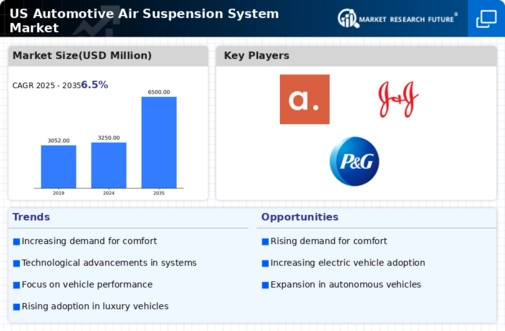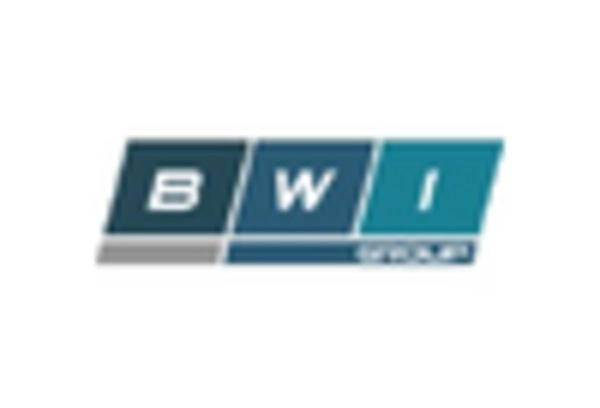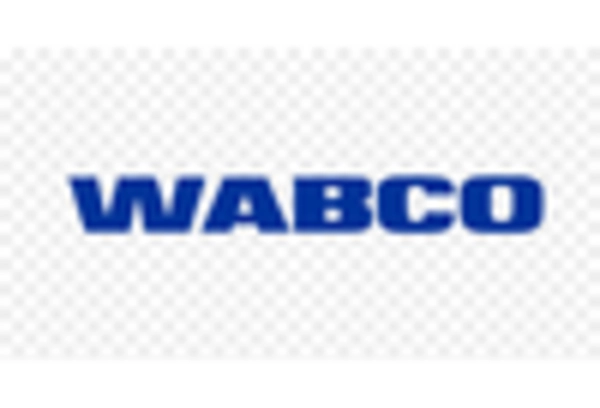Increased Focus on Vehicle Safety
Safety remains a paramount concern for consumers and manufacturers alike, driving advancements in the automotive air-suspension-system market. Enhanced stability and control provided by air-suspension systems contribute to improved safety features in vehicles. The National Highway Traffic Safety Administration (NHTSA) reports that vehicles equipped with advanced suspension systems have a lower incidence of rollover accidents, which is a critical factor for consumers when purchasing a vehicle. As safety regulations become more stringent, manufacturers are compelled to adopt air-suspension systems to comply with these standards. This focus on safety not only influences consumer purchasing decisions but also shapes the competitive landscape of the automotive air-suspension-system market.
Rising Demand for Luxury Vehicles
The automotive air-suspension-system market experiences a notable boost due to the increasing consumer preference for luxury vehicles. As more consumers in the US opt for high-end models, manufacturers are integrating advanced air-suspension systems to enhance ride comfort and vehicle handling. This trend is reflected in the sales data, which indicates that luxury vehicle sales have surged by approximately 15% over the past year. The incorporation of air-suspension systems not only improves driving dynamics but also elevates the overall driving experience, making it a key selling point in the automotive air-suspension-system market. As a result, automakers are likely to invest more in this technology to meet consumer expectations and remain competitive in a rapidly evolving market.
Growth in Electric Vehicle Adoption
The automotive air-suspension-system market is poised for growth as the adoption of electric vehicles (EVs) accelerates in the US. With the increasing emphasis on sustainability and energy efficiency, many consumers are transitioning to EVs, which often require advanced suspension systems to accommodate their unique weight distribution and handling characteristics. According to recent data, EV sales have increased by over 20% in the last year, indicating a shift in consumer preferences. Air-suspension systems offer the flexibility needed to optimize performance in these vehicles, making them an attractive option for manufacturers. As the market for electric vehicles expands, the demand for innovative suspension solutions is likely to rise, further propelling the automotive air-suspension-system market.
Regulatory Compliance and Emission Standards
The automotive air suspension market is significantly influenced by regulatory compliance and stringent emission standards imposed by government agencies. As the US government continues to implement policies aimed at reducing vehicle emissions, manufacturers are increasingly adopting air-suspension systems to enhance fuel efficiency and reduce overall vehicle weight. These systems can contribute to lower emissions by optimizing vehicle dynamics and improving aerodynamics. The Environmental Protection Agency (EPA) has set ambitious targets for emissions reductions, which compels automakers to innovate and integrate advanced technologies. Consequently, the automotive air-suspension-system market is likely to see increased investment as manufacturers strive to meet these regulatory requirements while maintaining performance and safety.
Technological Integration and Smart Features
The automotive air-suspension-system market is experiencing a transformation driven by the integration of smart technologies and features. As vehicles become more connected, the demand for advanced suspension systems that can adapt to varying road conditions is on the rise. Innovations such as real-time monitoring and automatic adjustments enhance ride quality and vehicle stability. The incorporation of these technologies not only improves the driving experience but also aligns with consumer expectations for modern vehicles. Data suggests that the market for smart automotive technologies is expected to grow by approximately 25% in the coming years. This trend indicates a strong potential for the automotive air-suspension-system market to evolve alongside advancements in vehicle technology.

















Leave a Comment